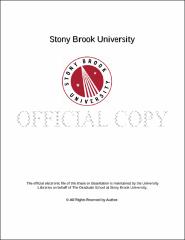| dc.identifier.uri | http://hdl.handle.net/11401/76592 | |
| dc.description.sponsorship | This work is sponsored by the Stony Brook University Graduate School in compliance with the requirements for completion of degree. | en_US |
| dc.format | Monograph | |
| dc.format.medium | Electronic Resource | en_US |
| dc.language.iso | en_US | |
| dc.publisher | The Graduate School, Stony Brook University: Stony Brook, NY. | |
| dc.type | Dissertation | |
| dcterms.abstract | Polymorphonuclear leukocytes (PMNs) act as first-responders to microbial infections in the human gingiva, primarily responsible for bacterial clearance. Dendritic cells (DCs) serve as the sentinels of the immune system and bridge the innate and adaptive immune responses by processing and presenting antigens to guide the T cell response. Recent research has shown that physical associations between these two cell types may result in mutually beneficial outcomes for both PMNs and DCs. Because the periodontal red complex pathogen Porphyromonas gingivalis through its minor fimbriae interacts with the C-type lectin receptor DC-SIGN on the surface of DCs, the same receptor that ligates to the Mac-1 integrin and CEACAM molecules on the surface of PMNs, it was hypothesized that this pathogen would interfere in DC-PMN conjugation. Infection of DCs with P. gingivalis did in fact thwart DC-PMN conjugation, however initial infection of PMNs with P. gingivalis caused an upregulation in surface integrins that leads to increased DC-PMN association. DC-PMN interaction in the face of P. gingivalis also lead to partially matured, highly migratory DCs that were capable of reversing apoptosis of infected PMNs and receiving bacteria by transfer from PMNs. Furthermore, the ability of PMNs to kill P. gingivalis while DCs appear to harbor viable bacteria suggests a complicated pathogen-host response interaction that may underlie the chronic nature of periodontal disease. Understanding the nature of the interactions between DCs and PMNs and their effects on P. gingivalis infection as well as the consequences for the innate immune response in the face of infection with this pathogen may lead to the detailed insight required for more effective, lasting means for treating chronic periodontitis. | |
| dcterms.available | 2017-09-20T16:50:45Z | |
| dcterms.contributor | Golub, Lorne | en_US |
| dcterms.contributor | Cutler, Christopher W. | en_US |
| dcterms.contributor | Gu, Ying | en_US |
| dcterms.contributor | Walker, Stephen | en_US |
| dcterms.contributor | Gelato, Marie | en_US |
| dcterms.contributor | Kachlany, Scott. | en_US |
| dcterms.creator | Scisci, Elizabeth | |
| dcterms.dateAccepted | 2017-09-20T16:50:45Z | |
| dcterms.dateSubmitted | 2017-09-20T16:50:45Z | |
| dcterms.description | Department of Oral Biology and Pathology. | en_US |
| dcterms.extent | 128 pg. | en_US |
| dcterms.format | Application/PDF | en_US |
| dcterms.format | Monograph | |
| dcterms.identifier | http://hdl.handle.net/11401/76592 | |
| dcterms.issued | 2015-05-01 | |
| dcterms.language | en_US | |
| dcterms.provenance | Made available in DSpace on 2017-09-20T16:50:45Z (GMT). No. of bitstreams: 1
Scisci_grad.sunysb_0771E_12370.pdf: 245320561 bytes, checksum: 75c98a3eef27f2a5c6751ca0d050aa23 (MD5)
Previous issue date: 2015 | en |
| dcterms.publisher | The Graduate School, Stony Brook University: Stony Brook, NY. | |
| dcterms.subject | Immunology | |
| dcterms.subject | Dendritic cells, P. gingivalis, PMN, Porphyromonas | |
| dcterms.title | Polymorphonuclear Leukocyte and Dendritic Cell Interactions in the Presence of Infection by Periodontal Pathogen Porphyromonas gingivalis | |
| dcterms.type | Dissertation | |

